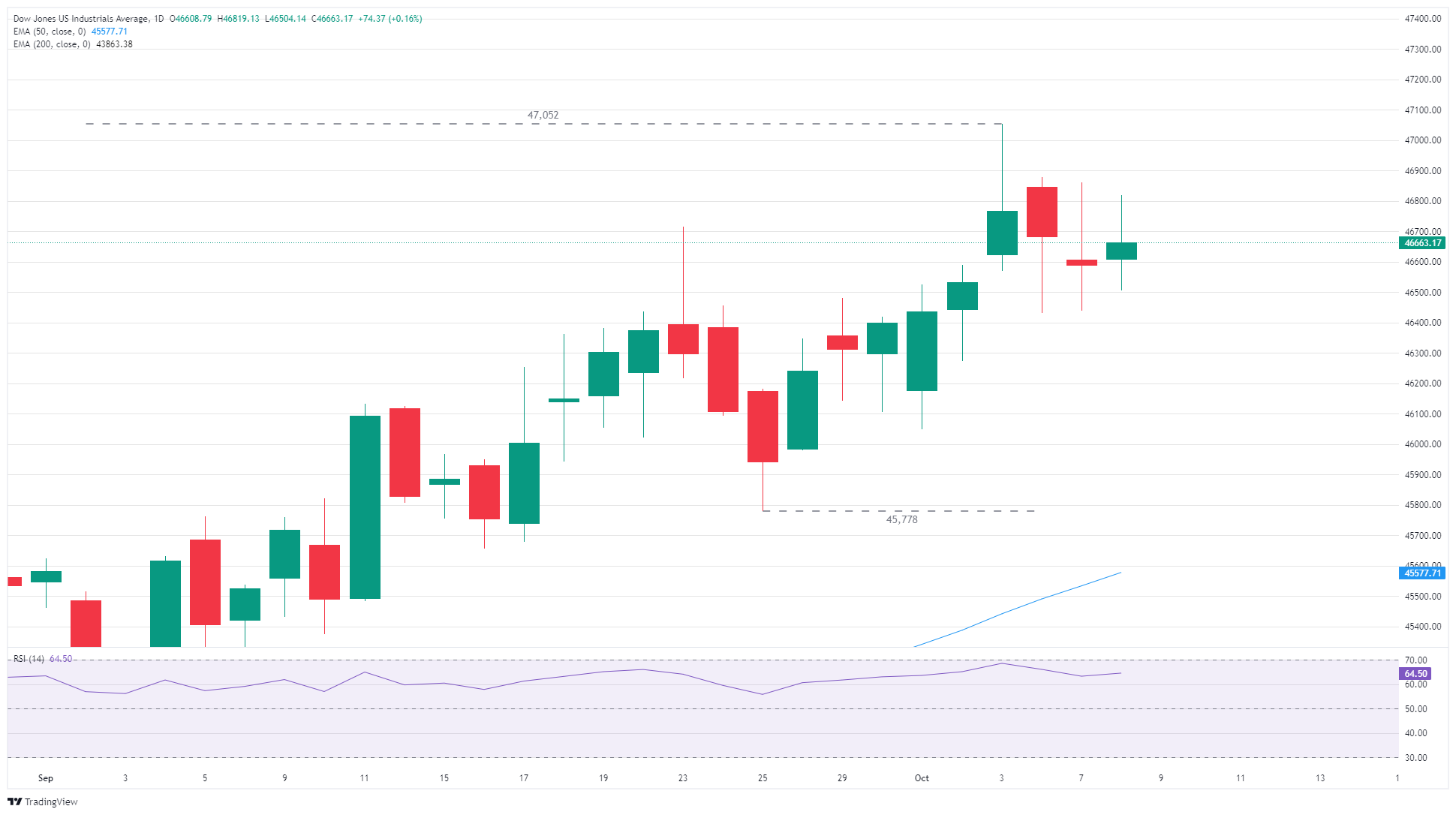Dow Jones Industrial Average looks for bullish footing on Wednesday
- The Dow Jones rebounded on Wednesday, briefly tapping 46,800.
- Equities are struggling to shake off a brief spat of risk aversion over the ongoing US shutdown.
- The AI rally continues to cough and sputter, but key hardware providers for the LLM segment still defy gravity.
The Dow Jones Industrial Average (DJIA) tilted back into the bullish side on Wednesday, recovering recently lost ground and retesting the 46,800 level as major indexes look to reestablish their top-heavy stance. Investors continue to shrug off the ongoing US government shutdown; however, several failed attempts to jumpstart federal operations on the Senate floor on Wednesday kept investor apprehension close to the surface.
The Federal Reserve’s (Fed) latest meeting Minutes confirmed that several Fed officials have indeed shifted lower on the dot plot, with policymakers generally acknowledging “downside risks” on the labor side of the Fed’s dual mandate. Despite a steeper curve in rate cut expectations from Fed voters, the Fed’s Gross Domestic Product (GDP) outlook through 2028 was revised higher.
According to the CME’s FedWatch Tool, interest rate expectations shifted slightly lower after the release of the meeting Minutes from the Fed’s interest rate decision in September. Rate markets are still pricing in over 92% odds of a follow-up interest rate cut on October 29, however widespread market hopes for a third straight interest rate trim on December 10 have come under threat. Fed Funds futures still see over 75% odds that the Fed will do a third straight cut in December, but odds are even higher that a third cut could be pushed out to January 2026.
With the Fed’s meeting Minutes out of the way, and the US government’s shutdown continuing to grind onward, investors will be looking ahead to this week’s University of Michigan (UoM) Consumer Sentiment Index update due on Friday. The UoM survey index is expected to tick down to 54.2 from 55.1, and traders will be keenly watching UoM 1-year and 5-year Consumer Inflation Expectations for any signs that inflation worries may become entrenched.
Dow Jones daily chart

Dow Jones FAQs
The Dow Jones Industrial Average, one of the oldest stock market indices in the world, is compiled of the 30 most traded stocks in the US. The index is price-weighted rather than weighted by capitalization. It is calculated by summing the prices of the constituent stocks and dividing them by a factor, currently 0.152. The index was founded by Charles Dow, who also founded the Wall Street Journal. In later years it has been criticized for not being broadly representative enough because it only tracks 30 conglomerates, unlike broader indices such as the S&P 500.
Many different factors drive the Dow Jones Industrial Average (DJIA). The aggregate performance of the component companies revealed in quarterly company earnings reports is the main one. US and global macroeconomic data also contributes as it impacts on investor sentiment. The level of interest rates, set by the Federal Reserve (Fed), also influences the DJIA as it affects the cost of credit, on which many corporations are heavily reliant. Therefore, inflation can be a major driver as well as other metrics which impact the Fed decisions.
Dow Theory is a method for identifying the primary trend of the stock market developed by Charles Dow. A key step is to compare the direction of the Dow Jones Industrial Average (DJIA) and the Dow Jones Transportation Average (DJTA) and only follow trends where both are moving in the same direction. Volume is a confirmatory criteria. The theory uses elements of peak and trough analysis. Dow’s theory posits three trend phases: accumulation, when smart money starts buying or selling; public participation, when the wider public joins in; and distribution, when the smart money exits.
There are a number of ways to trade the DJIA. One is to use ETFs which allow investors to trade the DJIA as a single security, rather than having to buy shares in all 30 constituent companies. A leading example is the SPDR Dow Jones Industrial Average ETF (DIA). DJIA futures contracts enable traders to speculate on the future value of the index and Options provide the right, but not the obligation, to buy or sell the index at a predetermined price in the future. Mutual funds enable investors to buy a share of a diversified portfolio of DJIA stocks thus providing exposure to the overall index.

